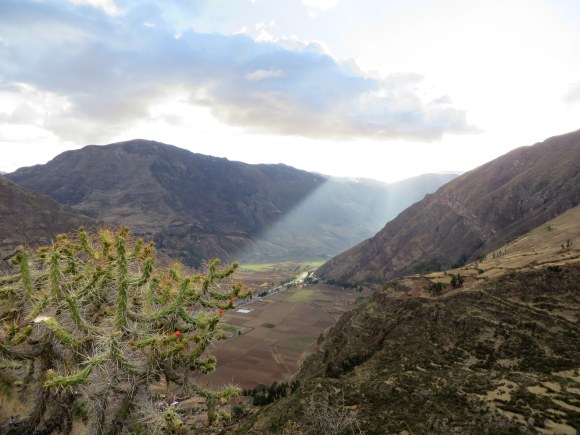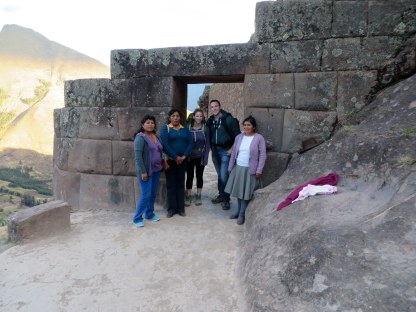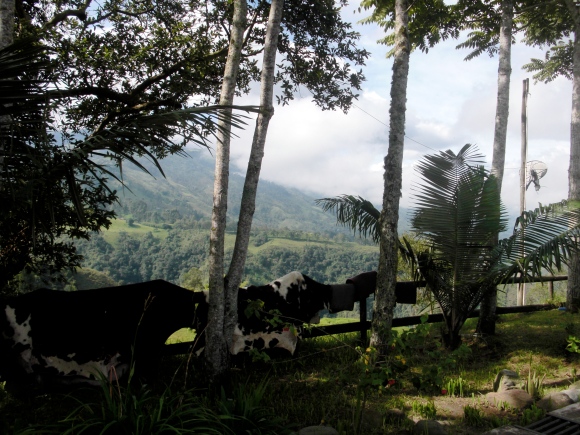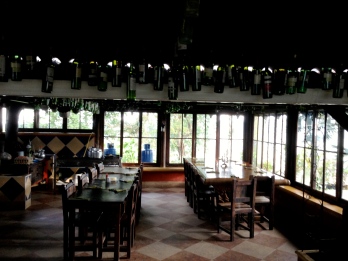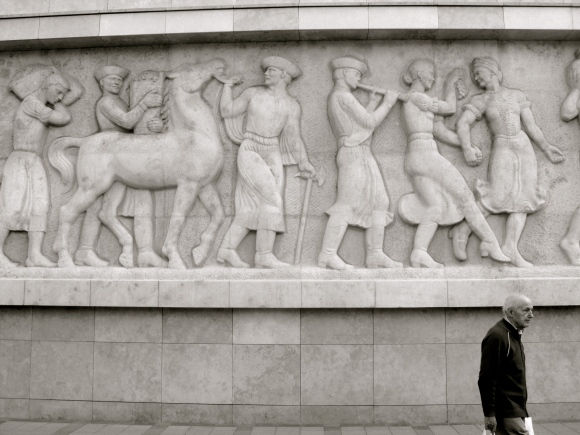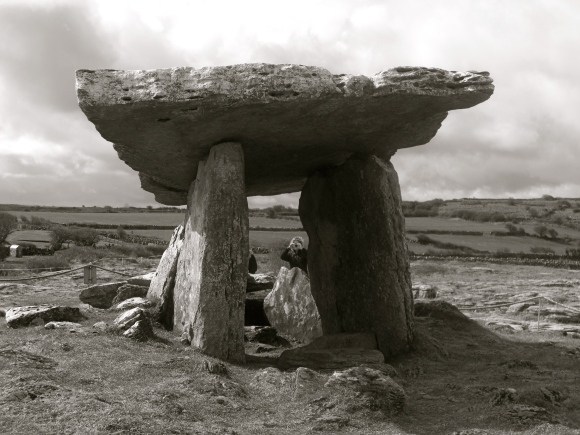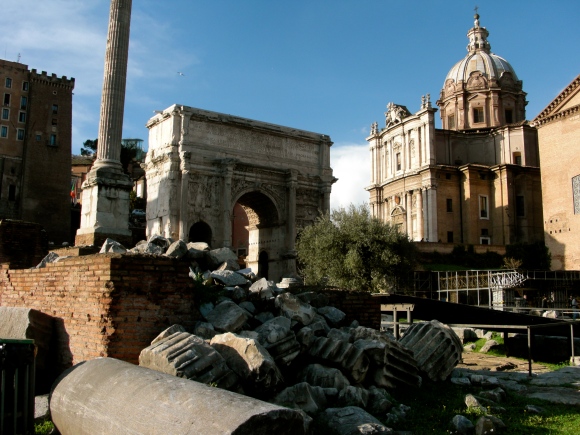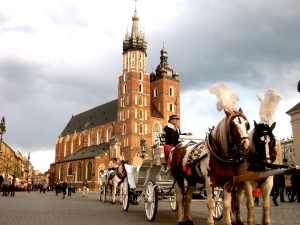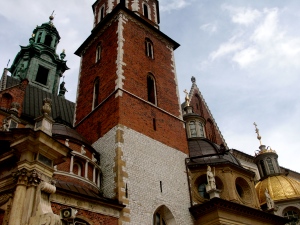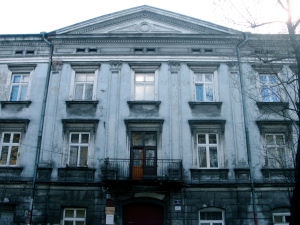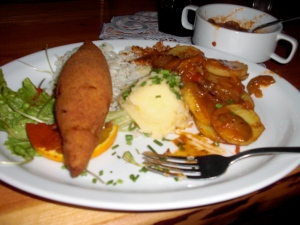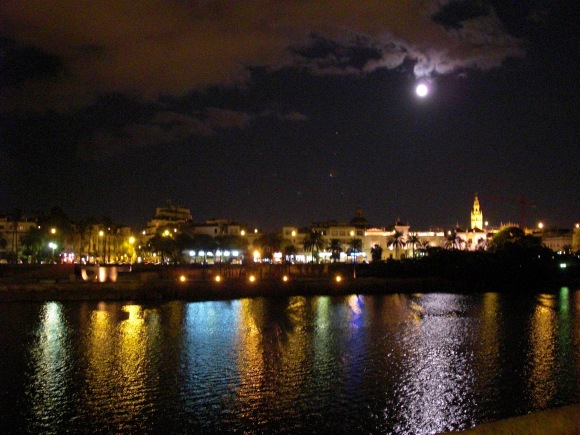The sun was getting lower, and our packs were feeling heavier as we climbed step after step towards the top.
“Are we even sure that there will be anything at the end of this?”
“I don’t know, but I sure hope so. I don’t want to climb this path going down in the dark.”
* * *
An hour and a half earlier Valerie and I had begun the climb of Pisac’s famous ruin site.
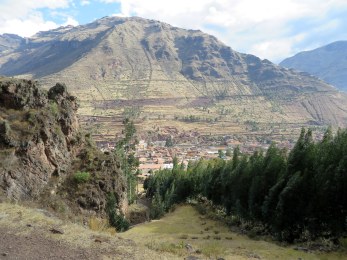 Pisac, located in Peru’s Sacred Valley, is a simple town, with a weekly market that sells Andean wares to tourists. We’d arrived via colectivo bus from Ollantaytambo. We’d just hiked on that town’s great fortress in the fierce Andean sun, and some up to some other smaller ruins surrounding the town.
Pisac, located in Peru’s Sacred Valley, is a simple town, with a weekly market that sells Andean wares to tourists. We’d arrived via colectivo bus from Ollantaytambo. We’d just hiked on that town’s great fortress in the fierce Andean sun, and some up to some other smaller ruins surrounding the town.
After perusing the market, and making a few trinkey purchases, we walked to the official entrance of Pisac.
We showed the attendant our Cusco Tourist Tickets, which can be used at any of a large amount ruins of the great Inca Empire in the Sacred Valley or Cusco.
The site officially closed at 4. It was 3.
Plenty of time to walk up to the top, linger for a bit to enjoy the view, and hike down in time to catch a taxi to Cusco, where we had a hostel booked for the night, we thought.
Pisac sits at 9,700 feet above sea level. The weather in the area is warm, and the mountains around that part of the Sacred Valley were dry, with sharp-looking plants and cacti dotting the landscape. The altitude, especially when like us you’ve only just arrived to Peru, has you huffing and puffing in just a short time of walking uphill.
The first ten minutes hiking the ruins were tough. To make it worse, we had on our 30+ pound backpacks, as we we had no hotel in town to store them. It was late afternoon, but the sun was still shining strong on my face.
On our left we passed endless levels of terraced flats, rimmed by the sturdy Incan stonework we’d see everywhere on our trip. Each level had a set of large stone steps carrying us upward.




We’d hiked for 30 minutes when we finally spotted the top of the ruins.
“Right up there must be it,” I said.
As we approached the end point, something didn’t seem right.
The trail, instead of going where it appeared to lead, bent sharply right, taking us away from the section of mountain we thought was Pisac’s highest point.
“What? That’s not the top?” said Valerie?
“I guess not. We need to keep going this way I guess.”
We veered to the right for 30 more minutes. Panting, we spotted some other hikers coming down the path.
“Hey guys. How’s it going?” one of the travelers asked.
“Good, how we doing? Almost to top?” I asked him.
“Yeah, you guys are probably about a quarter of the way there.” He said.
What? We thought. Only a quarter of the way?!
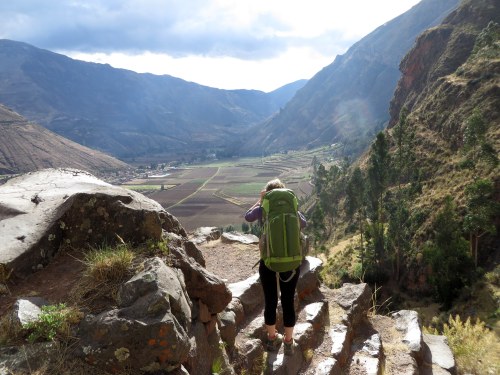 Before we had left for Peru, Valerie had read that the ideal way to see Pisac was to take a taxi. The part we had unfortunately missed was that most people take the taxi to the top, and walk down to where we had started. Instead of letting gravity do the work, we were fighting it in the thin air with 30 pounds on our backs!
Before we had left for Peru, Valerie had read that the ideal way to see Pisac was to take a taxi. The part we had unfortunately missed was that most people take the taxi to the top, and walk down to where we had started. Instead of letting gravity do the work, we were fighting it in the thin air with 30 pounds on our backs!
We debated whether we should even keep going to whatever “the end” was.
“Well, we’ve gone this far we might as well just finish it. We can head back down if it’s too far to reach,” said Valerie.
I was worried that when we reached the end of wherever this trail led, we wouldn’t have a way to get back down to the town, and we’d be stranded in the Peruvian Andes somewhere without transportation, after dark.
We restocked with a couple bottles of water bought from a local woman high up on the trail (who also tried to sell us homemade bracelets), and hiked on up the platforms.
Our legs were exhausted, and our lungs were heaving from the thin mountain air. Every 6-7 steps, we had to stop to catch our breath.
Almost there. We kept ascending.
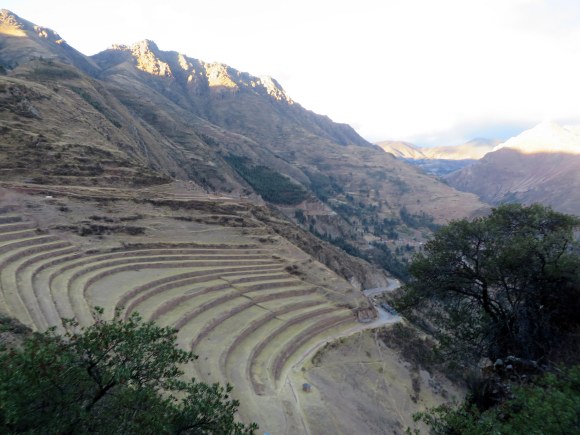 Finally, an end was in site. Just up ahead, the trail finally flattened out (as much as it can among the jagged mountains of Peru), and we could walk on flat ground along the trail again. We had climbed platform after platform, and were gazing down now at the Sacred Valley below, in a golden hour, while the sun poured down over the reddish rock and gave it a peaceful and beautiful glow.
Finally, an end was in site. Just up ahead, the trail finally flattened out (as much as it can among the jagged mountains of Peru), and we could walk on flat ground along the trail again. We had climbed platform after platform, and were gazing down now at the Sacred Valley below, in a golden hour, while the sun poured down over the reddish rock and gave it a peaceful and beautiful glow.
It’s easy to understand how the Sacred Valley was for centuries the economic and religious backbone of the Incan empire. The land is fertile, and the mountains mystical, as they wrap around the green-blue river below. The peaks are unlike any I’ve seen before, rising sharp and jagged as they jut up from the valley floor. Pisac’s ruins held all of this beauty and more, situated high above it all. What a view it must have been every single day!
As we found our way towards the end of the trail, we passed countless other ruins, which we would later find out were entirely different archaeological sites. We walked past local indigenous families, enjoying a beautiful day with a walk through the mountains.
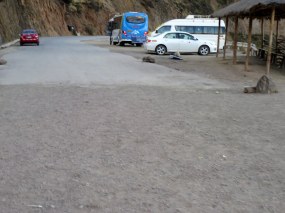 When we finally reached a parking lot, we found one single taxi, waiting on a few Israeli girls that he had just dropped off to explore the ruins. He told us we were welcome to split the fare back, if it was OK with them.
When we finally reached a parking lot, we found one single taxi, waiting on a few Israeli girls that he had just dropped off to explore the ruins. He told us we were welcome to split the fare back, if it was OK with them.
Once they returned we drove back to the town of Pisac, and negotiated a fare to Cusco, over an hour and a half away. Our driver took us back up through the mountain passes we had descended when we had travelled to the Sacred Valley, rising ever higher in the Andes and negotiating switchbacks on our way through small Andean villages and into the colonial structures and bustling Incan capital of Cusco.
* * *
Our trip to Pisac as the highlight of our trip to Peru in many ways. Though Macchu Picchu is spectacular, it is busy and heavily-trafficked by tourists. Taking the long way up to Pisac got me ready for the 5 day Salkantay Trek that lay ahead, building strength in my legs and acclimatizing my lungs, all while providing a thrilling journey with no end in sight.
I’d love to return there some day to repeat the hike, and the challenge of the long way up.

